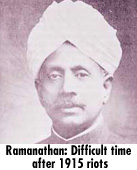
2nd January 2000

![]()
One of the "greatest" Ceylonese
Justice P. Ramanathan recalls his illustrious grandfather
 Ponnambalam
Ramanathan dominated public life in Sri Lanka in the early part of the
20th Century. He made a substantial contribution to the national life of
this country. This silver-tongued orator had a remarkable career. He touched
life in many points with distinction. The legislature, the law, education
and his contribution to Hinduism. He built the exquisite Ponnambalavanes-warar
temple in Colombo.
Ponnambalam
Ramanathan dominated public life in Sri Lanka in the early part of the
20th Century. He made a substantial contribution to the national life of
this country. This silver-tongued orator had a remarkable career. He touched
life in many points with distinction. The legislature, the law, education
and his contribution to Hinduism. He built the exquisite Ponnambalavanes-warar
temple in Colombo.
He served two periods in the legislature, where he spoke on public issues without fear. He served 32 years in the legislature. First as a nominated member and later as an elected member.
The first member to be elected to represent the educated Ceylonese community was Ramanathan. He was elected in 1912 to the Legislative Council where the whole island was the electorate. This was the beginning of the elective principle in the country. The total number of eligible voters in the country was only 2,934, as they had to satisfy certain educational or financial qualifications.
The results were:
Ramanathan 1,645 votes
Dr. Marcus Fernando 981 votes
Majority 664 votes
Abstentions 308
The most difficult time Ramanathan had to face was after the 1915 riots. The colonial rulers had competely misunderstood the causes of the disturbances. They imagined this was a rebellion against the rulers and declared marial law. Then under the cover of martial law the colonial rulers took the most barbaric action against prominent Sinhalese Buddhists, whom they locked up without trial.
Prof. K.M. de Silva states that Ramanathan rose to the defence of the Sinhala leaders in a series of speeches in condemnation of the excesses committed by the army in suppressing the disturbances.
He also opposed the two draconian acts namely the Indemnity and the Damages Ordinances which imposed a collective levy on all Sinhalese residents of specified localities regardless of their innocence.
The great tragedy was that Ramanathan had no support from the nominated Sinhalese representative, S.C. Obeysekera, who condemned the Sinhala leaders and backed the colonial action taken.
Ramanathan demanded a Commission of Inquiry to go into the action taken for the riots. He went to England and placed his case before members of parliament. The colonial office wanted the matter closed as they did not want their mistakes exposed. Ramana-than's conduct of fearlessly fighting for the Sinhala Buddhists when all others were silent made D.S. Senanayake say that Rama-nathan was one of the greatest Ceylonese of all times.
They sought the vote
Young Nimal De Fonseka now 77, witnessed the making of history
The ladies gathered at Sravasti, the stately home of her grand aunt Mrs W.A. de Silva and though she was just a little girl of four or five, she was taken along. "They piled into the great cars and headed for Queen's House where they were to be granted an audience with members of the Donoughmore Commission who had come to Ceylon to determine what its constitution would be." The delegation was on a mission to Queen's House: to state their case for universal suffrage.
The little girl who insists that she was just 'an appendage' though witness to this historic event, was Kalutaravedage Nimal Indrani De Fonseka. "I remember the Governor's wife seated there as Miss Nell (later Mrs George R. de Silva), sister of the famous Dr Andreas Nell, spoke of how it was time the women of Sri Lanka had the vote. I listened leaning against my grand aunt's chair. I later realised what a battle they fought, to get those rights." Among the ladies she remembers that day were some prominent names of yesteryear, Lady Panabokke, Lady Arunachalam, Miss Cissie Cooray and Mrs H.M. Peries. A year after British women were granted voting rights, this privilege was accorded to the women of Ceylon, in 1931, decades ahead of many 'developed' countries.
Her memories are understandably hazy, but that early brush with history led the young girl born to a 'privileged life' to grow up into a woman who had the country's interests close to her heart.
"Buddhism and nationalism were always part of the picture." Much travelled from her youth, she married L.S.B. Perera, who went on to become ambassador for Ceylon in Canada in the late Sixties during the Dudley Senanayake government and promoted the country with pride, wearing 'only handloom sarees, never Indian'. Her grand uncle W.A. de Silva, a great scholar, philanthropist and freedom fighter had predicted that she would shake more royal hands than her aunt who had met seven members of royalty and two American presidents. And true enough, at Expo '67, his prediction came true when she met many heads of state.
The golden days at Sravasti are gone. "It is a new Sri Lanka," she says, but for one who has seen the passage of time and many elections, the memories will remain.
More..
![]()
Please send your comments and suggestions on this web site to